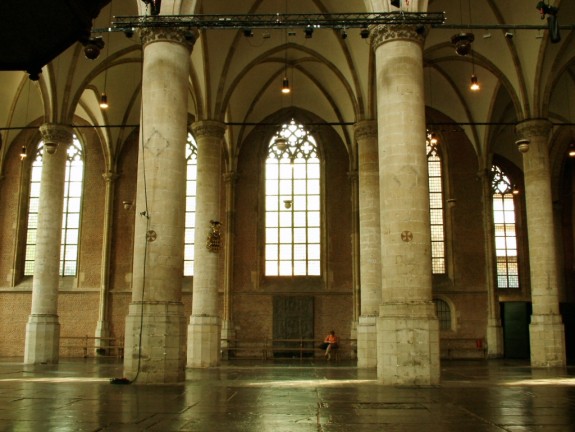They Celebrate American Thanksgiving in the Netherlands
From 1609 to 1620, many of the Pilgrims who came to America lived in the Netherlands

The Pieterskerk in Leiden, The Netherlands, was a site frequented by the Pilgrims who landed at Plymouth Rock in 1620. Photo: Eelco
The story of early America— told again and again this time of year—usually goes like this: the Pilgrims took off in the Mayflower from Plymouth, England, to dock at Plymouth Rock, in 1620, in what would one day become Massachusetts. One bit that’s often skipped over is the period in which many Pilgrims lived and worked in the city of Leiden, in the Netherlands, ahead of their voyage to the new world. But in Leiden, the connection is still strong enough that every year, on the day of American Thanksgiving, people gather in a 900-year old church known as Pieterskerk to celebrate the perseverance and good fortunes of the early American settlers.
In 1620, the ship Speedwell left from Leiden to Southampton, England. The passengers moved over to the Mayflower, and from there set upon their their long voyage to America. From 1609 to 1620, many of the assorted clustering of people known as the Pilgrims had resided in Leiden, working, running a printing press, and bolstering their numbers. Bart Plantenga for American Heritage:
The Pilgrims had evaded English persecution through the peculiar tolerance of the Calvinist Dutch, who had given them a religious safe haven upon their arrival in 1608. By 1609 the newcomers had settled in Leiden, whose city fathers declared they could “refuse no honest people free entry to come live in the city.” In Leiden the Pilgrims joined other British exiles amid a population of students, intellectuals, and refugees, including Gypsies, Mennonites, Lutherans, and Muslims.
While in Holland, the Pilgrims attracted some new members from England and from what is now the French-speaking part of Belgium, then occupied by the Spanish. Among the latter were Jean Pesijn and his wife, Marie de la Noye, Walloons from Lannoy, France. Relatives of theirs were passengers on theMayflower , and in 1621 their son Philippe sailed across in pursuit of a woman, effectively ferrying the surname Delano (as in Franklin Delano Roosevelt) to America.
According to Plantenga, many of Holland’s cultural mores were brought over to the Americas by the Pilgrims who had spent time in Leiden.
Bangs can rattle off examples of Dutch influence in the New World, such as the ladder-back chair, wood-planked house construction, and perhaps even Thanksgiving, which some suggest is based on an annual October commemoration of the 1574 lifting of the Spanish siege of Leiden. Administrative strategies that the Pilgrims exported from Holland included the division of colonies into boroughs, care for the poor, civil marriages (which foreshadowed the American Constitution’s separation of church and state), and inheritance laws giving children the right to inherit equal shares of their parents’ estates.
But more than just ideas can be linked back to those who left from Leiden. Nine American presidents, including the current President Obama, can trace their heritage back to this early group of Pilgrims.
More from Smithsonian.com:
The Pilgrims Before Plymouth
What Was on the Menu at the First Thanksgiving?
/https://tf-cmsv2-smithsonianmag-media.s3.amazonaws.com/accounts/headshot/smartnews-colin-schultz-240.jpg)
/https://tf-cmsv2-smithsonianmag-media.s3.amazonaws.com/accounts/headshot/smartnews-colin-schultz-240.jpg)